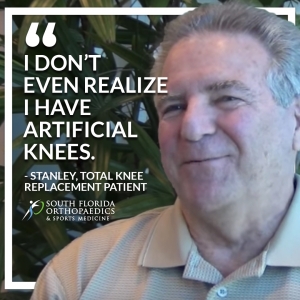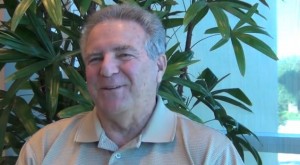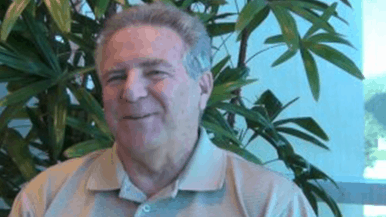- What Is a Total Knee Replacement and How Is It Performed?
- What’s the Recovery Process Like for a Total Knee Replacement?
Knee pain can be debilitating. Pain caused by arthritis or knee injury can make walking without assistance difficult or even impossible. When there seems to be no other option, Total Knee Replacement can help patients regain the ability to walk and virtually extinguish the pain they felt before the surgery.
“I don’t even realize I have artificial knees,” says Stanley, a recent patient of Scott M. Desman, M.D., at South Florida Orthopaedics & Sports Medicine. “I virtually do everything – I bowl, I golf, I do work around the house heavier than normal work. And I don’t even think about my knees.”Total Knee Replacement is one of the most successful medical procedures in the country according to the American Academy of Orthopaedic Surgeons (AAOS). More than 600,000 successful Total Knee Replacements are performed each year in the U.S., according to the Agency for Healthcare Research and Quality.
For his Total Knee Replacement, Stanley trusted Dr. Desman, a member of the American Academy of Orthopaedic Surgeons, as well as a fellowship-trained orthopedic surgeon with special training in hip and knee replacements.What Is a Total Knee Replacement and How Is It Performed?

The knee is a weight-bearing joint essential for support and moving, but is the most commonly injured joint in the body. Knee pain can stem from arthritis, injury, obesity, overuse and other processes. A Total Knee Replacement is a treatment option for people with severe knee damage when all other treatments fail.
For a Total Knee Replacement, patients must undergo anesthesia and 1.5 hour surgery. A cut is made in the front of the knee and the damaged surfaces of the joint, including cartilage and bone are removed. A custom-fit, artificial joint is then attached to the thigh bone, shin and knee cap. The artificial joint will then rely on the muscles and ligaments for support and function.
This differs from a Partial Knee Replacement, which is typically a treatment option for patients who have arthritis or knee pain limited to just one part of the knee. With a Partial Knee Replacement, Dr. Desman uses MakoPlasty® technology. This is a robotic assisted minimally invasive procedure that only resurfaces a portion of the knee rather than the entire knee. This is typically performed as an overnight stay or on an outpatient basis, and the recovery is accelerated when compared with a Total Knee Replacement.
“When we perform a Total or Partial Knee Replacement at South Florida Orthopaedics, we take special care to make sure the procedure is done right the first time,” says Dr. Desman. “You can feel confident that your knee replacement joint is custom-fitted, safe, reliable and durable.”What’s the Recovery Process Like for a Total Knee Replacement?

After the Total Knee Replacement, patients will stay in the hospital for one to three days. Patients can stand and start moving the joint the same day of surgery and are typically encouraged to move the joint.
“To get out of bed the next day and stand up on your toes is amazing to me,” says Stanley, who has had two Total Knee Replacements.
At first, patients may use a walking device like a walker or cane, but after about six weeks most patients are walking with little assistance. Patients will also undergo several weeks of physical therapy and strength conditioning.
“After the surgery, our patients go through physical therapy, an important part of the recovery process, to strengthen their muscles,” says Dr. Desman. “Not long after the surgery though, patients can participate in most activities, except running and high-impact sports.”
With a successful Total Knee Replacement surgery, Stanley is thankful for being pain-free and being able to walk without assistance.
“I couldn’t have had a better experience,” says Stanley. “Whatever [Dr. Desman] did, whatever his group did, everything was fine.”
